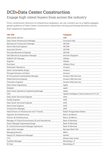We have seen nothing short of a data-driven revolution in the last few years. For end-users, data-intensive applications like AI may appear to process data and arrive at insights out of thin air, but, of course, data centers tell a different story.
The rise of AI has significantly driven demand for data centers by requiring immense computational power, vast storage capacities, and low-latency connectivity to process and analyze massive datasets efficiently.
This data-hungry demand is pushing North American data center prices to $163.44 kW/month, with growth showing no signs of slowing over the next 12 months, according to a recent report by JLL.
What does today’s data center demand mean for business?
The demand for data center capacity is fueling a boom in data center construction in new locations, as well as secondary and even tertiary markets, and capacity is expanding at existing data centers.
According to JLL, 83 percent of capacity at sites under construction is already pre-leased, and data center vacancy is running at an all-time low. In a digitally-led age where data confers a competitive edge, the availability of data center capacity is rapidly becoming a C-suite issue. As with other disruptive technologies before it, data-intensive applications like AI will create some surprising winners and losers.
Let’s take, for example, New York City, the quintessential business hub and capital of enterprise, which recently outranked Singapore and London as the most attractive financial center in the world.
At present, there is an acute shortage of data center space in New York. NYC lacks both the real estate and the power capacity to build new data centers, and consequently, data center investments in the city have lagged behind other major hubs.
Over the past decade, Greater New York saw only a four percent growth in data center power capacity developments, while cities like Dallas and Phoenix, with ample space for new construction projects, saw increases of 150 percent and 400 percent, respectively.
Technical challenges businesses face in the search for more data center capacity
It’s not just data center locations that are changing. What were previously multi-tenant data centers housing data operations for numerous businesses are now edging towards single-tenant spaces dominated by strategic large-scale corporations such as hyperscalers or large multinationals.
For businesses seeking to relocate their data center operations outside space-limited city centers like New York, the challenge of finding suitable data center space is compounded by issues such as service disruption and downtime (during the migration) and overcoming potential latency (once installed further afield).
Delays in accessing critical data directly impact business performance. Low-latency connectivity is a competitive imperative in a world that increasingly prizes real-time data processing, especially for the growing use of AI inference for all manner of business decisions and processes.
The environmental cost of capacity
Financial costs and peak performance are understandably the priorities for businesses. Still, an altogether greater existential threat looms as the environmental impacts of intense data processing, such as generative AI, become better understood. Spiraling energy consumption, predominantly from non-renewable sources, and significant cooling requirements contribute to substantial carbon emissions.
The appetite for power-hungry data processing shows no sign of abating. Instead, investment and innovation are being focused on optimizing efficiency. Google has had notable successes in reducing power consumption, harnessing AI to cut cooling costs by 40 percent.
An AI system pioneered by Google strategically selects global data center sites based on natural environmental advantages that will help power and cool facilities carbon-neutrally.
Data center design is being reconfigured to support shifting power demands more efficiently, and innovations in fields such as interconnection are helping to make high-performance processing more sustainable.
When it comes to AI, the training of LLMs, for example, is not latency-sensitive. As a result, the vast amount of processing required for training purposes can be handled by data centers that are located in distant, climatically advantageous regions where renewable energy sources are in unlimited supply, and the cooling load can be kept to a minimum.
However, AI inference – actually making use of AIs for critical and business-critical use cases like self-driving vehicles and the connected ambulance, real-time analysis, business decision-making, and customer services – requires low, even single-digit, latency. For such use cases, a data center in Dallas or Phoenix cannot support the needs of businesses in NYC.
The benefits of data center expansion
While it’s undeniable that businesses are facing stiff competition from hyperscalers, pressures around power consumption, and operational challenges as they increasingly seek data center capacity away from metropolitan hubs, it is also true that data center growth is a reliable indicator of business growth.
As NYC’s data center needs outstrip its current infrastructure capability, the wider region is poised to benefit in the form of multi-tenant data center infrastructure investment.
It’s a pattern we see replicated in many other regions where investment in data centers has been solid, but space is now scarce. For example, cities like Richmond in Virginia are becoming strategic hubs for data center growth thanks to their location and space, which in turn takes the strain off areas like Northern Virginia.
Data center expansion is good news for businesses, delivers growth and investment regionally, and takes the pressure off densely populated cities.
Overcoming operational difficulties to deliver secure, low-latency connectivity
However, given that data performance is mission-critical for business and with data center space at a premium, businesses now need solutions to ensure data centers further afield can still service the important business ecosystem in cities such as New York.
In urban, central data center environments, businesses have tended to use cross-connects to access networks in the same facility or peered via an Internet Exchange in the city.
The decision to relocate – and nonetheless avoid challenges such as latency – has resulted in a renewed focus on interconnection solutions in the form of distributed and data center-neutral Internet Exchanges.
Unlike inherently less secure and less controllable workarounds involving IP Transit, these interconnection platforms enable direct peering and cloud connectivity across multiple data centers, regardless of who the data center operator is, ensuring that data can move swiftly and securely between locations.
By leveraging secure, direct, low-latency connections, businesses can ensure that their operations remain efficient and uninterrupted, even when their data centers are situated outside their home city – allowing, for example, data centers in New Jersey to serve the needs of NYC businesses securely and in low latency.
Interconnection is critical for future data center capacity
Currently, New York is the only city in the US to host two large, distributed, and data center/carrier-neutral Internet Exchanges, NYIIX New York (interconnecting seven data centers) and DE-CIX New York (interconnecting 30 data centers across the entire metropolitan region).
Crucially, this means businesses relocating outside Manhattan can still take advantage of the city’s thriving ecosystem, and do so in low latency.
In future, data center growth depends on increasing investment in such interconnection ecosystems, which not only address the current challenges of relocating data centers but also boost the resilience and reliability of digital infrastructure regardless of the data center operator or location.
As demand for capacity rises, spurred on by continuing advances in generative AI, other cities will similarly need to up their competitive edge by ensuring secure, low-latency, high-performing data processing capabilities.
Investing in interconnectivity now will enable businesses to seamlessly link diverse data center locations to meet their current and future needs.









